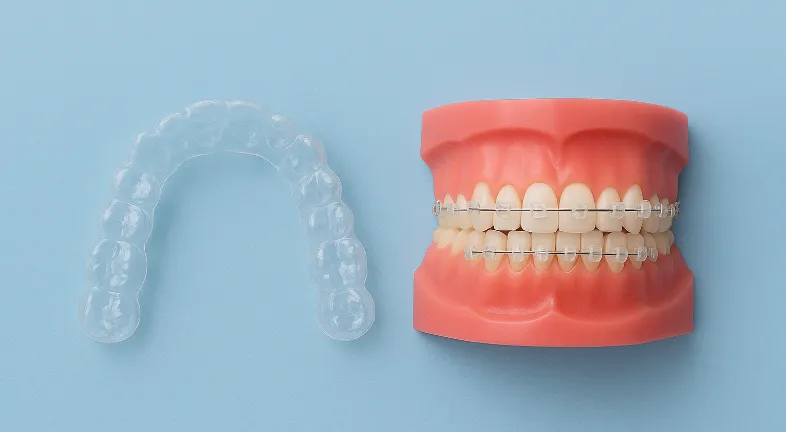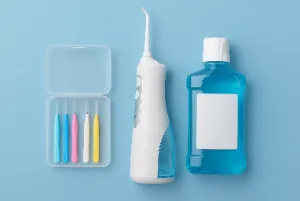
Table of contents
Clear braces are a popular choice if you want straighter teeth without the train-track look of traditional metal brackets. They blend in with your natural smile, which makes them especially appealing for adults and teens who want a more subtle orthodontic option.
But here’s the big question many people ask before committing: Do clear braces stain easily? And if they do, what can you actually do about it? Let’s break this down in a simple, practical way so you know exactly what to expect and how to keep your clear braces looking fresh throughout treatment.
There are a few different types of clear braces available, and each stains differently. Let’s explore this in a little more detail.
Do ceramic braces stain easily, you ask? Ceramic brackets (the clear or tooth-colored squares attached to your teeth) are made from stain-resistant materials. That means they’re built to stay pretty much the same color for the whole treatment.
However, the part that stains more easily is the elastic ligatures, those tiny rubber bands that hold the wire in place. They can pick up color from things like curry, coffee, or soda. Luckily, your orthodontist changes them out every 4–6 weeks, so the discoloration is temporary.
Clear aligners like those from Caspersmile are a little different since they don’t use brackets or wires at all. Instead, they’re removable plastic trays you swap every 1–2 weeks. Since you take them out to eat, there’s less risk of staining from food.
But here’s the catch: if you drink coffee, tea, or soda while wearing them, or if you don’t brush before popping them back in, they can become cloudy or slightly tinted. The good news is that since you switch to a fresh set so often, staining usually isn’t a long-term problem.
Here’s the part nobody loves hearing: some of your favorite foods and drinks are the biggest culprits. Common foods and drinks that stain clear braces include:
Even though you don't have to cut these out completely, being mindful about how often you have them and cleaning your teeth soon after consuming any of these makes a big difference.
Wondering, “Do clear braces turn yellow?” The honest answer is: not usually, as long as you take care of them.
In other words, yellowing is more of a temporary nuisance than a long-term problem.

Clear braces are amazing when it comes to functionality, but the constant fear of staining the brackets can lead to unnecessary anxiety. But trust us, just maintaining and developing a few simple habits can really keep clear braces stain-free:
Think of it like caring for a white shirt, you don’t stop wearing it, you just avoid things that might stain and wash it properly.
Sometimes, no matter how careful you are, elastics can still stain. Here are some practical cleaning tips:
And remember, replacing elastic bands is part of the process, so don’t stress too much if they stain before your next appointment.
Absolutely. For most people, the occasional elastic discoloration is a small trade-off for a more discreet orthodontic option. Clear braces are especially popular among adults who want effective treatment without the “metal smile.”
If you’re extra concerned about staining, talk to your orthodontist. They may offer self-ligating clear braces (which don’t use elastics) or recommend aligners as an alternative.
So, do clear braces stain easily? The brackets themselves don’t, but the elastics can due to food residue. With good care, mindful food choices, and regular orthodontic visits, you can keep your braces looking nearly invisible throughout treatment.
Pro Tip: Make a travel-size kit containing an intradental brush, floss, and mouthwash. This can help you tremendously in moments when you are in need of quick brace maintenance.




Curated the best for your knowledge
 Odontomas: What They Are and How They're Treated
Odontomas: What They Are and How They're TreatedSome dental conditions are quiet. Too quiet, in fact. Odontomas fall into that category. They rarely make noise, yet they change things beneath the surface. And people usually have no idea about them. While malocclusions, teeth shifting, discoloration, or other cosmetic dental issues are fairly well known, odontomas are not. So, an odontoma is technically a type of tooth tumor. It’s benign, harmless, but oddly structured. Hence, it can interfere with tooth eruption, displace teeth, or cause swelling. However, there’s more to it. Here’s a deeper dive.
Read More.webp) Gingivitis Treatment: How to Reverse Early Gum Disease
Gingivitis Treatment: How to Reverse Early Gum DiseaseGingivitis tends to creep up quietly, usually after a stretch of rushed brushing or nights where flossing just slips your mind. The first sign is often bleeding when you spit toothpaste into the sink. That moment makes people Google how to cure gingivitis, which is honestly the right instinct. Early gum inflammation happens because plaque irritates the tissue around the teeth. If you respond quickly, it is fully reversible. Most cases improve quickly with proper cleaning, hydration and small tweaks in daily habits. The key is not ignoring those early red or puffy gum signals.
Read More.webp) Metallic Taste in Mouth: Causes and How to Get Rid of It
Metallic Taste in Mouth: Causes and How to Get Rid of ItHaving metal taste in the mouth first thing in the morning can be an unexpected experience. You wake up, take a swallow, and suddenly have a metallic taste in your mouth, as if you'd been chewing on a handful of change. It's annoying, a little scary, and sometimes for no apparent reason. For some people, it will be nothing but a minor nuisance; others may fall into the late-night goose chaser. Sometimes it's a sign that there is something wrong with your braces; other times, it could mean that there is something wrong with one of your teeth. But here's the good news: Most metallic tastes are temporary, harmless, and can be treated or resolved. So let's take a closer look at the possibilities.
Read MoreQuick Links

Heading